In the future, it’s likely that the average person will not work for a company. Instead, people will earn income in non-traditional ways by taking actions such as playing games, learning new skills, creating art, or curating content. This kind of shift in how we work is not unusual or unexpected — the idea that most people would be employed by large corporations would have seemed crazy to someone in the year 1800.
This new future of work is enabled by the networks that form around crypto protocols, which are emerging as new ways of coordinating, measuring, and rewarding contributions to complex ecosystems. This shift is already beginning to unlock new earning potential for individuals, and it is leading toward a growing transfer of value capture from organizations to people participating as individuals in crypto networks.
The traditional way to make money was “work-to-earn,” but the future of income is “x-to-earn” — play to earn, learn to earn, create to learn, and work to earn.
That won’t happen magically, however — it will require new decentralized autonomous organizations (DAOs) that can coordinate all this new activity outside the context of corporate systems. And the earning opportunities available in DAOs will be a function of the different types of contributions DAOs need. This article offers a framework for understanding the options that will be available in the future of work.
The limits of companies as coordination mechanisms
First, we need to explain the shortcomings of existing earning models. Traditional corporate employment is rapidly becoming outdated as a means for coordinating activity in the Information Age — we already see this in the emergence of alternative forms of earning such as influencers, contractors, creators, gig economy participants, and more. These ways of earning don’t necessarily feel like “work,” but they are all examples of people participating as individual value providers in complex networks, and earning income for their contributions.
However, these non-traditional opportunities are limited in number, and when available, often under-reward a contributor’s value. That’s because these jobs are still based in a web2 paradigm in which corporations continue to control the business model.</p >
Increasingly, traditional corporations have “orbital stakeholders,” or participants that blur the line between internal and external members of the organization. Consider Apple and the developers that create App Store Apps, YouTube and creators, or Uber and their drivers — participants are contributing to companies’ bottom lines from the outside, but companies are having a difficult time aligning incentives with these stakeholders.
As companies grow, they are no longer able to maintain a sustainable relationship with these orbital network participants. The relationship between the company and the participants turns zero-sum, and in order to maximize profits, the company begins to extract value from these participants. This, according to Chris Dixon, is “Why Decentralization Matters”:

The model of a company having strict boundaries between internal and external may have made sense in the Industrial Age, but in the Information Age, this model leads to misaligned incentives and unsustainable extraction. In our world of complex information and orbital stakeholders, companies are no longer suited to help us coordinate our activity.
Crypto networks create better alignment between participants, and DAOs will be the coordination layer for this new world.
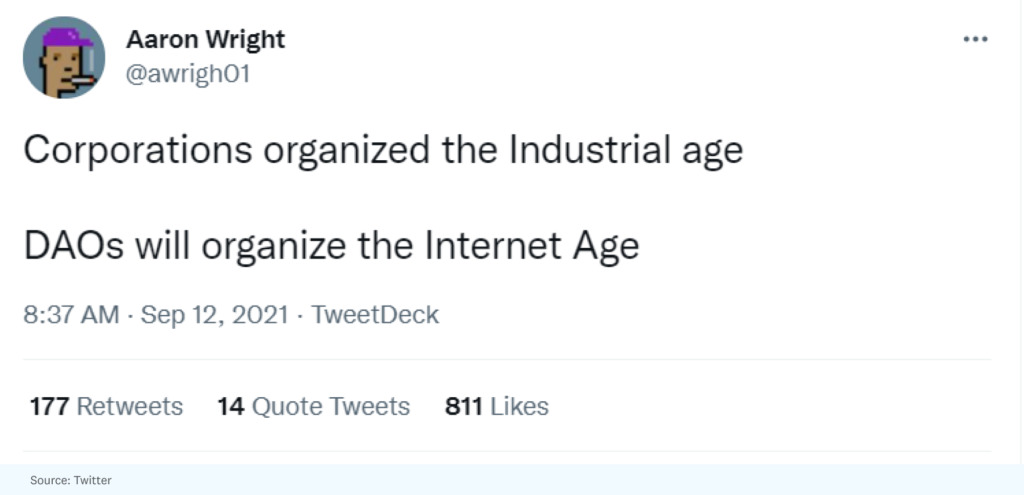
DAOs as a new coordination layer
DAOs will eventually replace the traditional model. A DAO is an internet-native organization with core functions that are automated by smart contracts, and with people who do the things that automation cannot (e.g., marketing, software development). In practice, not all DAOs are decentralized or autonomous, so it is best to think of DAOs as internet-based organizations that are collectively owned and controlled by its members.
Though it is still early in the evolution of DAOs, they are no longer just a hopeful concept. They are real organizations managing billions of dollars of capital, providing real products and services to millions of people, and creating new ways for people to earn an income.
Here is a nice overview of the current
DAO landscape by Cooper Turley:
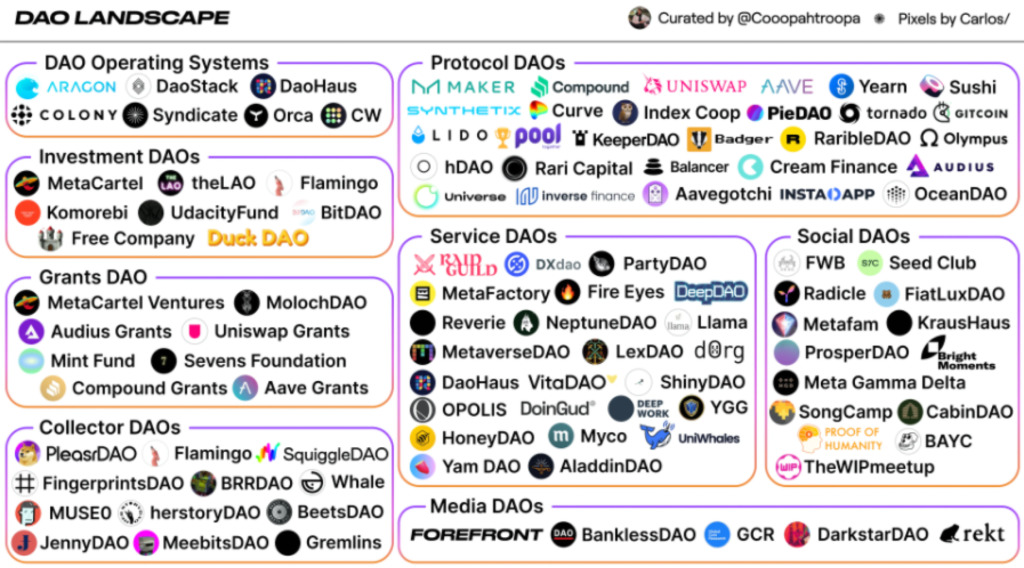
DAOs come in many different shapes and sizes: there are DAOs that govern crypto protocols (Protocol DAOs), DAOs that make venture investments (Investment DAOs), DAOs that provide services to other DAOs (Service DAOs), DAOs that purchase NFTs (Collector DAOs), and many more.
But across all DAOs, there are a few common threads that differentiate them from traditional organizations (these are generalizations, so please note they vary based on specific instances):

These elements that distinguish DAOs from traditional organizations are actually what enable DAOs to have a more symbiotic relationship with their stakeholders and participants. DAOs function as open economies, encouraging value to be accrued wherever it is provided, not based on an arbitrary legal border. From Chris Dixon’s article mentioned earlier:
Cryptonetworks use multiple mechanisms to ensure that they stay neutral as they grow, preventing the bait-and-switch of centralized platforms. First, the contract between cryptonetworks and their participants is enforced in open source code. Second, they are kept in check through mechanisms for “voice” and “exit.” Participants are given voice through community governance, both “on chain” (via the protocol) and “off chain” (via the social structures around the protocol). Participants can exit either by leaving the network and selling their coins, or in the extreme case by forking the protocol.
The structure of a DAO is inherently open and accountable, a forcing function to share value with the participants who create it. Otherwise, other DAOs will out-compete them or their participants will leave for other opportunities.
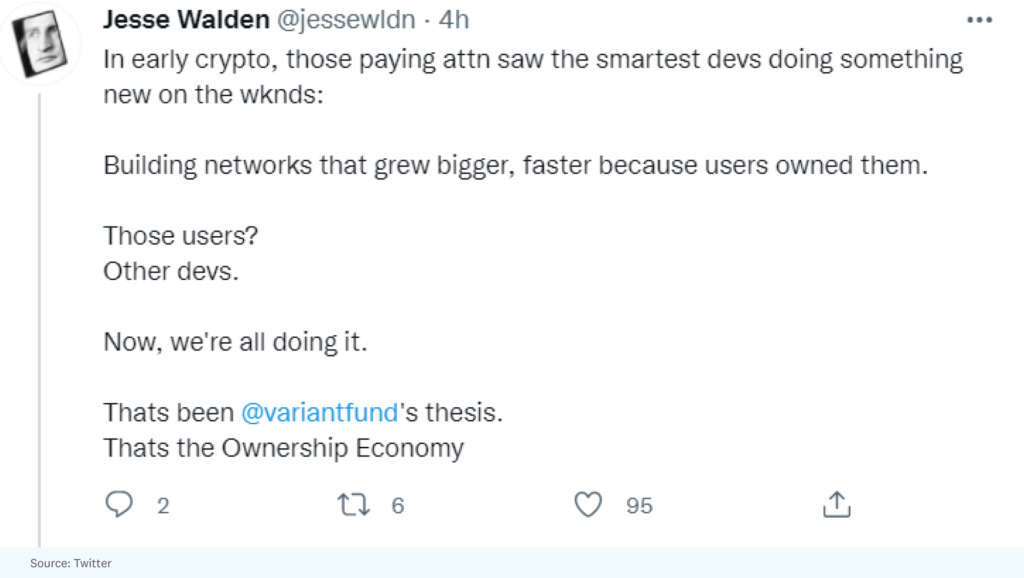
In fact, the best DAOs have been the ones that have rewarded their participants, serving as the basis of the Ownership Economy. This emergent positive-sum dynamic is the foundation of the x-to-earn trend that will shape the future of work.
The future of “work” in a DAO
To better understand the options that will be available to people, we must explore the anatomy of a DAO:
 Graphic inspiration from Brian Flynn, Zakku, and the Orbit team
Graphic inspiration from Brian Flynn, Zakku, and the Orbit team
DAOs as open economies will power the X-to-earn trend, which will make work more flexible, fluid, and playful than the 9-5s we are accustomed to.
The openness of these crypto economies will allow people to participate in several DAOs and crypto-networks, mixing and matching different income streams and ownership returns (remember, the best DAOs are distributing ownership to their participants through their own native token).
People’s income will be a mix of things we already currently do in our lives (e.g., play games), things we think of as traditional work (e.g., bounties / contracts), and things that are currently accessible to only a small percentage of the population (e.g., investing, passive income). To think of it another way, DAOs will expand the type and quantity of opportunities that are open to several types of participants, including token holders, bounty hunters, and core contributors.
For example, a tokenholder may earn some of their income from receiving grants to major DeFi protocols (e.g., Compound), from passive yield income on their various tokens, and some through returns as their ownership stakes appreciate over time; a bounty hunter will earn by completing incentivized on-chain actions; a network participant may earn from playing Axie Infinity or other “play-to-earn” games that will emerge.
In this new future of work, jobs will be more transient and dynamic — switching costs between jobs will be lower, opportunities will be more visible, work will be reduced down into more atomic units, and the entire world will be unified under a single workforce with access to all opportunities. We will discover new opportunities based on our on-chain history, ownership, and reputation, and we will be matched to contribute where we have the best comparative advantage.
Here is a closer look at the ways participants will see earning opportunities through DAOs.
Core contributors: work-to-earn
Core contributors are how we typically think of employees today — people focusing full-time on one (maybe 2-3 in some circumstances) project or organization. The singular focus allows the individual to be embedded within the project and amass contextual and strategic knowledge. Think of teams of wage-earners working together with the singular aim of advancing the economic growth of a corporation that provides most if not all of their income and includes hundreds or thousands of workers.
The need for focused and embedded workers will never go away, but this group of people will be much smaller in web3 than ever before. Software, and smart contracts to an even larger degree, enable small groups of people to create outsized impacts. Instagram was
famously acquired by Facebook for $1B with a team of just 13 people. This type of outcome will become common in the future as the power of software automation, along with a much larger network of smaller contributors, will keep the number of core contributor team members small.
In the future, working for this group won’t be demonstrably different from working for a company — DAOs will still have core contributors whose interests are most directly aligned with the health of the organization. Because DAOs are more transparent than corporations and can be held accountable by a larger community, however, there is added pressure (think about the scrutiny public officials are under).
Bounty hunters: contribute-to-earn
“Bounty Hunters” complete clearly defined work for an agreed upon price and / or duration of time. These people are often functional experts in areas such as finance, development, and design, who provide services to many DAOs at one time and fulfill specific tasks with clear boundaries.
Bounties are often posted openly for any person to claim, and can sometimes be competitive, rewarding the best submission based on merit and value contributed after the fact, not based on an up-front application process or bidding war. Reward for these bounties is often determined by grants committees or decentralized working groups who have been delegated some authority by the larger DAO (part of a larger trend called Governance 2.0).
Many Bounty Hunters will collectively join forces to form their own Services DAOs — think of these as organizations that provide outsourced help to DAOs that don’t have the required skills on hand. These Services DAOs are emerging to fulfill tasks that require functional knowledge such as treasury management (e.g., Llama), software development (e.g., RaidGuild), governance (e.g., Fire Eyes), and more.
Though Bounty Hunters and Services DAOs may just sound like contractors and professional services firms, they will be differentiated and more popular within DAOs for a few reasons:
- Smart contracts will automate a big portion of a DAO’s core function, leaving more peripheral work that is clearly defined, functionally specialized, and well captured through bounties.
- DAOs will deliberately try to push work to the peripheries to maintain decentralization and avoid large hierarchies, and bounties create a sustainable way to do that.
- The transparency of DAOs will make the coordination costs on bounties lower.
Network participants: participate-to-earn
This is the newest and perhaps most exciting part of the future of work. Within any given DAO, this is where the majority of people will fall.
Networks gain strength with more activity and additional participants, yet, for years, users, consumers, and participants have been adding value to networks without capturing their share of value (app developers for Apple, creators for YouTube, and drivers for Uber, for example).
Functioning more like open economies than closed organizations, DAOs will reward each individual contribution based on the value it provides, regardless of who it comes from. This means that everyday actions that are valuable to a network will be turned into income-earning opportunities.
Nearly every single person will earn some income from simply living their lives online, using products, and participating as a user. For people receiving compensation for their own participation in networks, earning an income will feel a lot like a game.
A few categories are already starting to emerge in this exciting space (check out Stephen McKeon’s awesome article for a deeper dive):
Play-to-earn
Play-to-earn is a new type of gaming model that rewards players for playing and achieving within a game. The traditional gaming model involves a one-sided transfer of value towards the game creators or platforms, whereas play-to-earn games reward users as well.
Play-to-earn games function like an economy: Players provide labor (their time and energy) and capital (often purchasing NFTs to participate in the game) and are rewarded with fungible tokens for their achievements and progress within the game. Earning currency from games isn’t new, but instead of rewarding players with in-game currencies confined to usage within the game, play-to-earn games distribute fungible token rewards that are swappable for other crypto tokens or fiat currencies.
This means that video game players can literally pay their bills through their in-game achievements, particularly for people in countries with lower wages and living expenses. This phenomena is already a source of income for millions of people, most notably through Axie Infinity.
Axie is a popular blockchain game in which players buy pet NFTs (Axies), breed them, battle with them, and trade them. These actions occur in the game, but each user actually owns the Axies they purchase or create. The game has exploded in popularity over the last few months, earning over 200k ETH (currently $860 million) in combined revenue in July and August (these numbers have since declined, which is the subject of heated debate that I speak to more below).
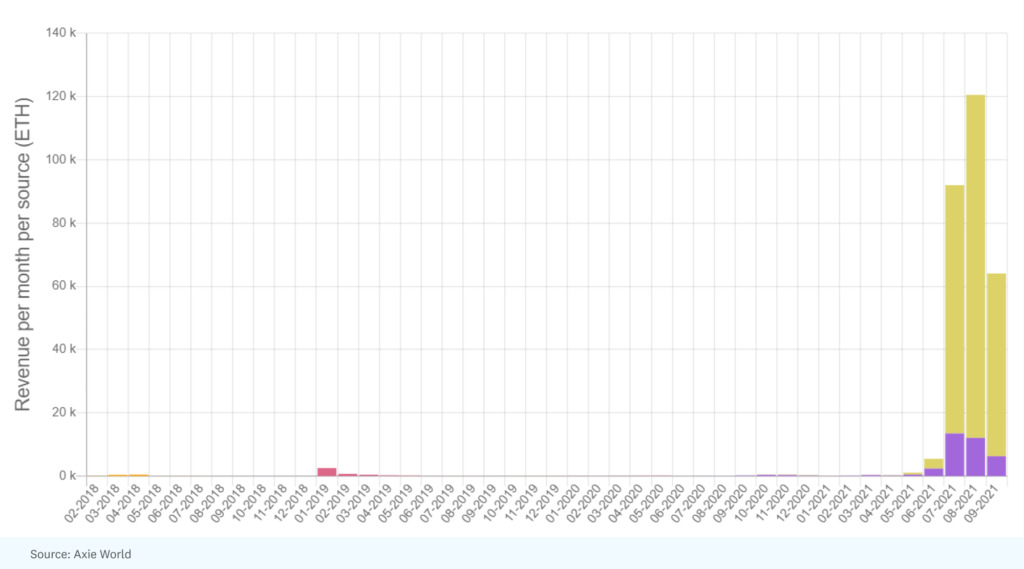 Source: Axie World
Source: Axie World
This explosive growth is attributable to the incentive alignment between Axie and its users, which Axie describes in the following way:
Axie has a 100% player-owned, real money economy. Rather than selling game items or copies, the developers of the game focus on growing the player to player economy and take small fees to monetize. Axies are created by players using in-game resources (SLP & AXS) and sold to new/other players. The holders of the AXS token are the government that receives tax revenues. Game resources and items are tokenized, meaning they can be sold to anyone, anywhere on open peer-to-peer markets.
Axie has blazed the path for play-to-earn and more importantly, has opened people’s eyes to the larger x-to-earn trend, showing how people can earn income by contributing to a network.
Learn-to-earn
Learn-to-earn is a new education model in which instead of paying to learn, a person is actually compensated for demonstrating that they have learned something. This is possible when the skill, knowledge, or information that a person learns adds value to a network, and that network is therefore willing to subsidize the learning.
On RabbitHole (where I work), crypto protocols pay for Quests, which incentivize users to complete specific actions on-chain. When users complete these actions, they earn rewards that are supplied by the protocol. Whereas bounty hunters are generally contributing to building the protocol, these on-chain actions tend to be about participation within the protocol.
This new positive-sum interaction helps all parties:
- Users learn a new skill or way to use crypto, and earn tokens for it
- Crypto protocols gain new, knowledgeable users
- RabbitHole gets a percentage of revenue for facilitating the interactions
This new model is akin to Google sharing some of their advertising revenue for learning about a new product, or a university paying you because you strengthen their alumni network. In both situations you were providing value to a network and not being rewarded, but now, you can be.
RabbitHole has distributed over $750k in rewards since launching, paid by some of the largest protocols in crypto (e.g., Uniswap, Aave, Compound, The Graph, Pool Together, and Polygon). Though this space is early, the potential for learn-to-earn rewards is enormous, if you consider the revenue that is generated from education and advertising that is not currently captured by users.
Create-to-earn
Crypto has created new wealth and digital scarcity, which has paved the way for an NFT market explosion over the last few months. This has opened up opportunities for artists across the world to make a living, or even generational wealth in some cases.
But this is not that functionally different from any artist being paid for their work when it is successful. What is more interesting is creators being paid for their value-add to networks, beyond the individual profits they make on their own work.
For example, NFT marketplace SuperRare recently airdropped 15% of its tokens to early users, collectors, and artists on their platform, to acknowledge the role that these value creators played in their early network success.
Audius, a decentralized protocol for music streaming, allows creators to earn tokens for uploading music and curating playlists. Audius is giving creators ownership stake in the network as a result of the value they are bringing.
Token holders: Invest-to-earn
The ability to invest in high-growth opportunities will be democratized to anybody with an internet connection and a crypto wallet.In a world where every network has a token, tokens are earned for participating in networks, and the ability to purchase tokens is permissionless, every single person becomes an investor. Investments will turn into a major source of income for an increasingly large portion of the population. Not every investment will appreciate, but individuals will have access to opportunities that were previously reserved for a select few, and a whole class of income earning opportunities will be unlocked.
What is needed to enable DAOs and the future of work
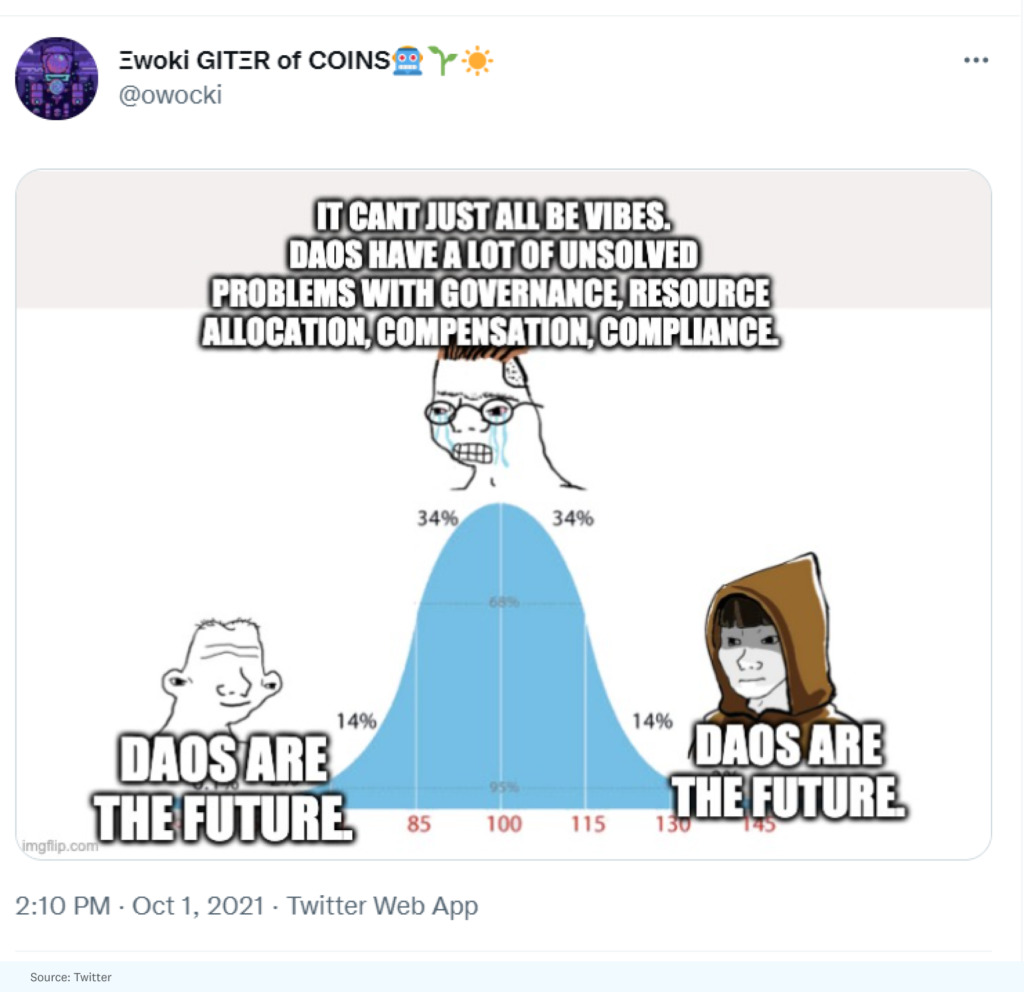
X-to-earn opportunities only become mainstream if DAOs become mainstream. DAOs show a lot of promise, but they are still early, and have a long way to develop until the future-of-work is realized. In a recent survey of 422 DAO participants conducted by Gitcoin and Bankless, <45% of respondents said that DAOs are their primary source of income.
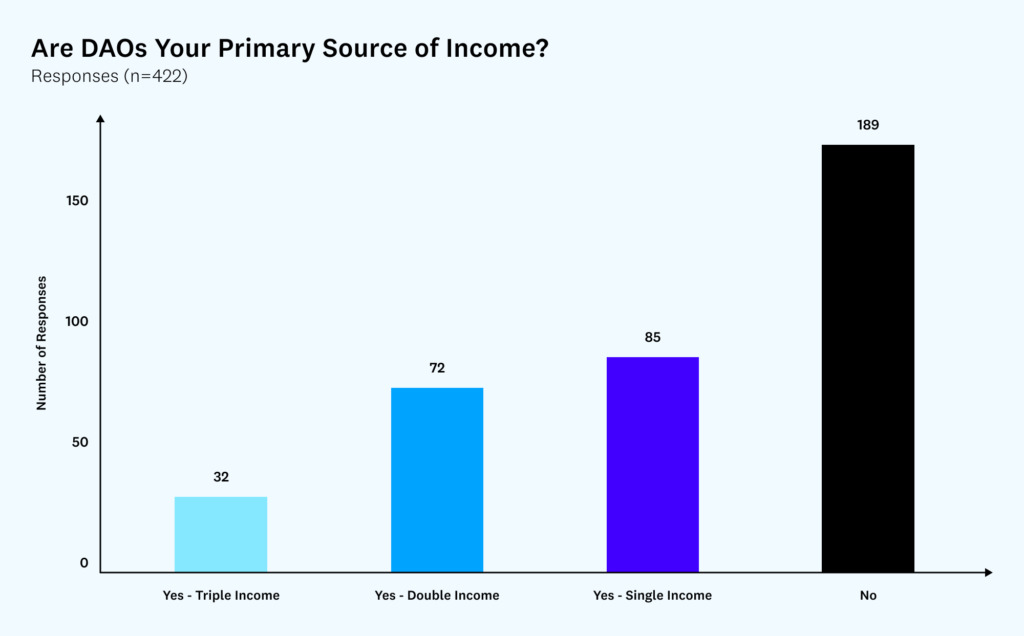
For DAOs to truly become the center of work, we need to develop infrastructure, tools, and systems that can support DAOs and their members.
Most DAOs are currently relying on a mix of web2 software that was not made for DAOs or web3 software that is incredibly young. In both cases, DAOs needs are not being fully met.
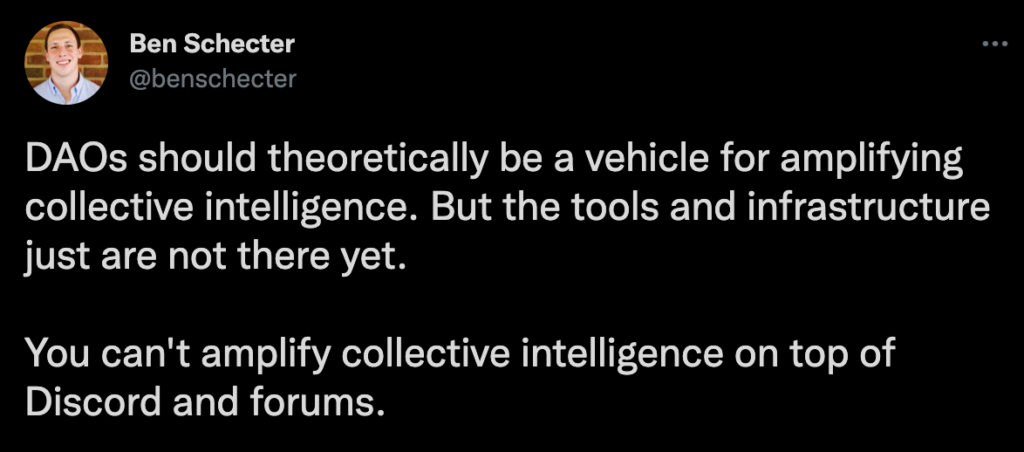
DAOs have an incredible potential to harness the power of decentralized networks and people’s collective intelligence, but they will need better software tools to coordinate. DAOs will need tools that support governance (e.g., Snapshot, Orca), software collaboration (e.g., Radicle), treasury management (e.g., Parcel, Multis, Gnosis), discussion (e.g., Discourse), access (e.g., CollabLand) and more.
Especially relevant to this essay, one interesting area where new solutions are needed is rewarding contributors. DAOs do not have a CEO or an HR department to decide who should get paid for what, so new, decentralized ways are needed to determine how much value a person contributes and what they should be paid for it. A few early, but interesting solutions include having colleagues determine each other’s rewards (Coordinape) and using an algorithm to create a contribution graph and calculate rewards (SourceCred).
Reputation systems
DAOs are open and permissionless, but still need new ways of determining who to trust, collaborate with, and reward.
The traditional company solution is to conduct extensive interview processes, but these run opposite to the ethos of a DAO. Further complicating matters is that many of the people involved in DAOs are pseudonymous. In this new world, DAOs need a new way to figure out who to allocate scarce resources towards.
This highlights the need for on-chain reputation systems. On-chain reputation systems will capture our actions that occur on blockchains: our contributions to DAOs, our governance voting history, our token holdings, and more. Ultimately, reputation systems will use these on-chain actions to make predictions about how we will act in the future to make determinations about who is trustworthy, credible, and aligned. On-chain reputations will replace the way companies currently use credentials, resumes, and interview processes.
However, there are many privacy and security concerns regarding tracking a public ledger of actions tied to a person’s identity. Right now, blockchain identity largely revolves around addresses, but for these reputation systems to become viable, we will need much stronger decentralized identifier solutions (e.g., Ceramic / IDX) and identity management.
Caveats: On creating value, and possible pitfalls
It is unclear, in the long-term, how much income can be earned through these outlets. X-to-earn does not mean every single person will be able to make art and play video games for a living.
X-to-earn is about rewarding value where it is created. DAOs make these non-traditional paths more sustainable and available for more people, but the market will not reward everyone. Market dynamics are still relevant, and to be rewarded, you will need to provide value. Creators will need to find audiences, game players will need to achieve outcomes, and bounty-hunters and contributors will need to create an impact.
However, the ongoing debate around the sustainability and magnitude of certain earning opportunities does not take away from the thesis of this essay: creating value within networks should be rewarded, and DAOs will coordinate the value reward within crypto networks enabling new income earning opportunities.
More broadly, the future-of-work won’t be unequivocally good. As with any major technological shift, there are often positives and negatives. Crypto, and DAOs more specifically, will result in the same. Here are some areas to watch:
Competitiveness and disparities
Measuring and rewarding all contributions to a network will lead to a more meritocratic allocation of resources. The flipside of meritocracy is a world in which DAOs actually increase the power laws that web2 economies have previously demonstrated. On Spotify, for instance, the top 1.4% of creators make 90% of royalties. Further, truly global workforces with lower switching costs only increase these competitive dynamics. How will people reconcile increased discrepancies in outcomes if DAOs exacerbate this trend?
Cognitive overload
There are limits to how much the human brain can process. Dunbar’s number is the notorious limit for how many social relationships the human brain can manage, but “DAObar’s number” is the DAO version of that: how many DAOs can a person be meaningfully involved in? Each subsequent DAO involvement is an increase in the processing power needed to maintain context and awareness of everything going on. DAO tooling for communication and collaboration (discussed above) will attempt to mitigate this, but people may struggle with the extra overload.
Disconnectedness
On one hand, DAOs allow people to choose how they work and associate with communities where they are value-aligned. On the other hand, by reducing much of work into atomic units and purely financial incentives for actions, we risk reducing people’s meaning to purely financial rewards. We risk turning work into discrete, meaningless tasks, where labor is reduced down to a commodity service.
***
There is a common trope that the future is already here, it just isn’t evenly distributed. That is certainly the case with DAOs and the future-of-work. Everyday, more people are joining DAOs and jumping into web3 full-time. DAOs are growing quickly and have an enormous need for talent to help them achieve their missions. Whether it’s full-time or part-time, there are ways to work, learn, and get involved. Use Station to find web3 opportunities, enter the Mirror write race, curate on Yup, vote on a proposal on Snapshot. The future of work is emerging and it will go in unexpected and fascinating directions.
Thanks to Brian Flynn, Jesse Walden, and all the others mentioned for their inspiration through conversations and afar.










